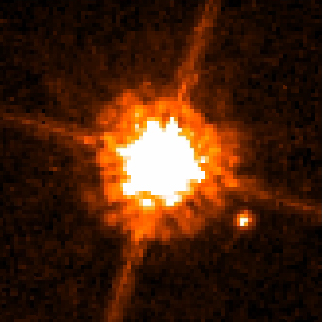







| BOOKS | F. A. Q. | ARTICLES | TALKS | ABOUT KEN | DONATE | BEYOND OUR KEN |
|---|
By Ken Croswell
November 6, 2006

Image of the red dwarf CHXR 73 by the Hubble Space Telescope. NASA, ESA, and K. Luhman (Penn State University).
Three of the nearest red dwarf stars with planets all have less iron than the Sun, say astronomers in Texas. The discovery is a surprise, because heavy elements like iron make up the bulk of most planets in the solar system.
Most known extrasolar planets orbit stars with spectral types of F, G, or K, stars that are about as hot and luminous as the Sun. Not surprisingly, these planet-bearing Sunlike stars tend to have high abundances of heavy, planet-forming elements--abundances that match or surpass the Sun's.
But the few red dwarfs known to have planets violate this rule, say Jacob Bean, G. Fritz Benedict, and Michael Endl at the University of Texas at Austin. Red dwarfs are smaller, cooler, and fainter than the Sun. They account for three fourths of all stars in the Galaxy, including the Sun's nearest neighbor, Proxima Centauri. Yet red dwarfs glow so feebly that not a single one is visible to the unaided eye.
Bean and his colleagues obtained high-resolution spectra of three nearby planet-bearing red dwarfs--Gliese 876 in Aquarius, Gliese 581 in Libra, and Gliese 436 in Leo--by using the Hobby-Eberly and Harlan J. Smith telescopes at McDonald Observatory in Texas. The spectra allowed the astronomers to measure metallicities, the stars' abundances of elements heavier than helium.
Measuring red dwarf metallicities is a challenge. First, the stars are dim, but spectroscopic determinations of metallicity require excellent spectra, which in turn require lots of photons from a star. Second, the stars are so cool that atoms in the stellar atmospheres join to form molecules, which complicate the analysis.
Nevertheless, Bean and his colleagues succeeded in measuring the metallicity of each red dwarf. Surprisingly, in every case, the star had a lower metallicity than the Sun:
| Star | Alternate Name | Constellation | Distance (light-years) | Spectral Type | Temperature | Metallicity
| Gliese 876 | Ross 780 | Aquarius | 15 | M4 | 3,478 K | 76 percent solar
| Gliese 581 | Wolf 562 | Libra | 20 | M3 | 3,480 K | 47 percent solar
| Gliese 436 | Ross 905 | Leo | 33 | M2.5 | 3,498 K | 48 percent solar
| |
"This result makes the Gliese 876 problem even worse than it already was," comments Gregory Laughlin at the University of California at Santa Cruz. Gliese 876 has two Jupiter-mass planets, and Laughlin says forming such huge planets from the disk of material orbiting a small star is troublesome--even if the metallicity were high. "If the metallicity is low," he says, "it's even harder to understand. I would really like to know what happened for Gliese 876."
In contrast, the even lower metallicities of the other two stars, Gliese 581 and Gliese 436, pose no trouble, Laughlin says, because they have only Neptune-mass planets, and Neptune is just 5 percent the mass of Jupiter. "Even in a low-metallicity disk," he says, "there's still plenty of solid material available for forming giant planets" with Neptune's mass. As a result, Laughlin predicts no correlation between a star's metallicity and the likelihood it has Neptune-mass planets. However, a strong metallicity-planet correlation should exist for Saturn-mass and especially Jupiter-mass planets.
Bean and his colleagues are measuring metallicities of other red dwarfs. The astronomers want to see whether red dwarfs in general have lower metallicities than Sunlike stars. If so, that might explain why few planets have been found around red dwarfs.
The new work is not the first to find lower metallicities among a group of planet-bearing stars. In 2005, astronomers reported that several giant stars with planets are metal-poor.
Bean and his colleagues will publish their work in a future issue of Astrophysical Journal Letters.
Update (April 20, 2009): John Johnson at the University of Hawaii and Kevin Apps in England say that astronomers have underestimated the metallicities of red dwarf stars. In a paper to appear in The Astrophysical Journal, Johnson and Apps say that when these metallicities are corrected, planet-bearing red dwarfs are in fact metal-rich--just as planet-hosting Sunlike stars tend to be.
Ken Croswell is an astronomer and the author of Magnificent Universe and Ten Worlds, which describes the ten largest worlds that orbit the Sun--including Pluto and newly discovered Eris. He has previously written about the possibility that red dwarfs might have life.
"Magnificent Universe by Ken Croswell is elegant and eloquent."--Washington Post. See all reviews of Magnificent Universe here.
"On the basis of its striking design and photographs, this handsome, large-format volume is well worthy of praise. And astronomer Croswell's concise yet conversational, information-packed text wins it sky-high accolades in the narrative sphere as well."--Publishers Weekly, starred review. See all reviews of Ten Worlds here.
| BOOKS | F. A. Q. | ARTICLES | TALKS | ABOUT KEN | DONATE | BEYOND OUR KEN |
|---|